
The New York Times
JOEL-PETER WITKIN
by Grace Gleuck
Joel-Peter Witkin: Vintage Work
Hasted Hunt
529 West 20th Street, Chelsea
Through Feb. 18
The calculated madness of Joel-Peter Witkin's photographs conveys a sense of 19th-century horror, like the dreamworks of the Symbolist painter Gustave Moreau. Mr. Witkin's over-the-top epics are often inspired by well-known paintings, or even by contemporary photographers like Diane Arbus. Freaks abound, death and disfiguration play important roles (sometimes involving actual cadavers or their parts), and gruesome juxtapositions occur, like tiny bronze skulls and genuine severed genitals. His work, too, is rife with props: masks, sadomasochistic devices and stuffed animals not least among them.
Sometimes he can be campily comic, as in "The Fool" (1993), a parody of the pompous equestrian portraits of European kings. Against a misty sweep of landscape, a ruler wearing an exaggerated hat and ruffled under-pantaloons poses on a prancing horse mounted on a platform. One disembodied arm holds not a sword, but a stick. He is closely attended by a small, sardonic jester wearing a mask and boxer shorts and wielding a drumstick. At his feet a half-naked woman lies next to a dead cow, perhaps symbolic of the monarch's subjects.
But what Stephen King calls grue abounds in Mr. Witkin's "26-Year-Old O.D." (1982), a portrait of a youth whose partly dissected body belies the peacefully sleeping look of his head, its black hair partly covering one eye. In "Feast of Fools" (1990), a takeoff on a 17th-century still life, Mr. Witkin substitutes severed body parts for fruits, flowers and other delectables. In "Prudence" (1996), meant to illustrate spiritual forces versus the demons of the unconscious, he dresses an attractive nude in elbow-length black gloves and a piled-up head wrap that holds, among other goodies, two dead bats. Still, you don't have to buy into Mr. Witkin's Stygian visions to realize there's a master of surrealistic photography at work.